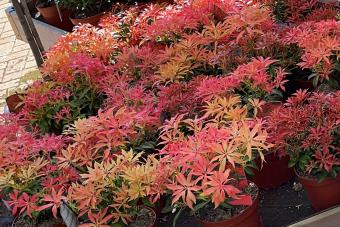
Pieris is a broadleaf evergreen shrub that has leathery, slightly glossy green leaves. It produces an abundance of pretty pink or white bell-shaped blooms in late winter, making among one of the earliest-blooming shrubs you can grow in your garden. It's a wonderful option for foundation plantings or shrub borders, but it's worth keeping in mind that it's toxic to humans and pets.
Growing Pieris in Your Garden
Pieris shrubs grow nine to 12 feet tall and up to eight feet wide. Pieris, also known as lily of the valley shrub or Japanese andromeda, is hardy in Zones 5 through 8.
Where to Plant Pieris: Light and Soil Requirements
Pieris grows best in full sun to partial shade. This isn't a plant for dry spots; it needs fertile, moist, well-drained soil to thrive. For optimal moisture retention, and to help reduce the amount of weeding you'll need to do, it's a good idea to apply a three- to four-inch layer of mulch around your pieris shrubs.
Pieris grows best in acidic soils, though it does tolerate neutral soils as well.
Watering and Fertilizing
Pieris needs moist soil, so if you get less than an inch of rain per week, be sure to water. Adding mulch will help reduce the amount of watering you'll need to do.
In terms of fertilizer, the best type is one that's formulated for other acid-loving flowering shrubs such as azaleas and rhododendrons. Apply the fertilizer according to the package instructions. You might also want to consider side-dressing pieris with compost in spring to increase the soil fertility.
Pruning Pieris
Other than removing the spent flowers (which prevents pieris from setting seed, encouraging more bloom), these shrubs really don't need much pruning. Remove any dead wood and prune as needed to keep it looking the way you want it. They have a fairly neat, even growth pattern, so there really isn't any shaping involved in pruning pieris.
Pieris Pests and Diseases
The most common issue gardeners deal with when growing pieris is fungal issues. You can reduce the chance of this being a problem by giving them plenty of room, ensuring there's good airflow.
Beautiful Pieris Varieties to Grow in Your Garden
Pieris varieties are available in a range of sizes and bloom colors, so it should be easy to find the perfect one for your garden. If you plant a few different varieties, you can get an extended bloom time, as long as you choose varieties that flower at different times.
Cavatine

Pieris japonica 'Cavatine' is a dwarf variety of pieris, growing up to about two feet tall. This late bloomer (blooming in May) produces an abundance of cream-colored blossoms.
Flaming Silver

Pieris japonica 'Flaming Silver' has gorgeous, variegated foliage that starts out a pinkish shade. It produces white flowers in early spring.
Little Heath Green

'Little Heath Green' is a dwarf variety of pieris that only grows to about 30 inches tall, making it a wonderful addition to borders, but also for growing in containers.
Mountain Fire

'Mountain Fire' pieris is a stunner. Its evergreen foliage is deep, glossy green, but newly-emerging foliage is fiery red, appearing just before the creamy white flowers. This is a large shrub that can reach 10 feet tall and wide at maturity.
Red Head

Pieris japonica 'Red Head' is a dramatic-looking plant, with glossy green leaves and vibrant reddish-pink flower buds that develop into creamy white flowers. This is a larger variety, growing to about eight feet tall and wide.
Gorgeous Blooming Evergreens for Your Garden
Pieris is truly the best of all worlds: attractive, evergreen foliage, gorgeous blooms, and easy to grow, as long as the soil and moisture conditions are right. While you will need to be careful about its toxicity, if you can keep kids and pets away from it, it's definitely worth growing.







